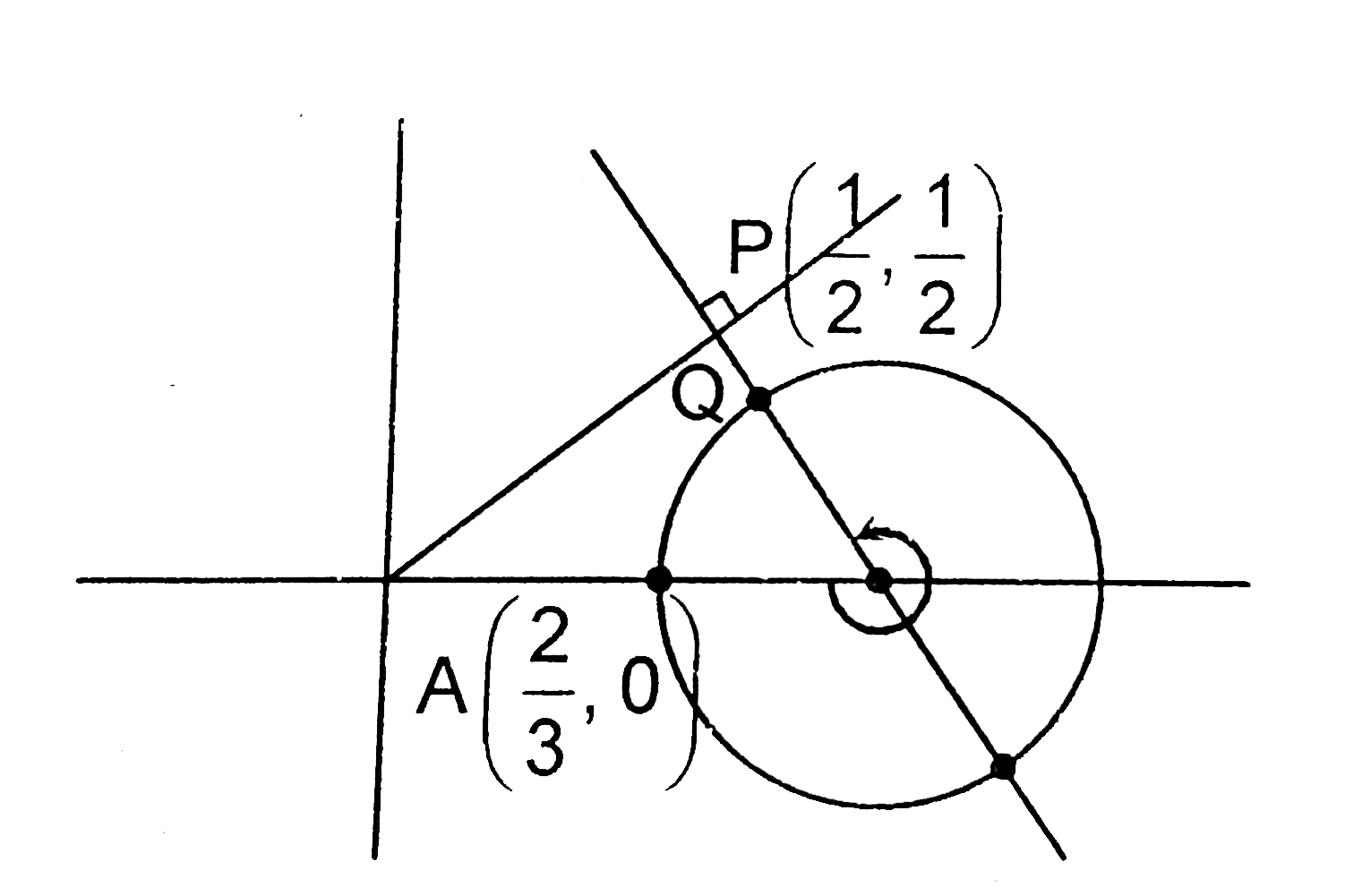A particle P moves on the line y=x,x≤0 with constant speed um/sec. Another particle Q revolves along the circke (x−1)2+y2=19 with constant speed ω3m/sec. In anticlockwise directio, let at t=0, both P and Q simultaeously started, P from the point (0,0) and Q from he point (23,0). Further at any time instant t sec, let the distance of theri separation is r(t)m. Also it was observed that at time t0 sec, both P and Q are at their closest distance of approach, denoted by rminimumm, then choose the correct statements from among the following
[12rminimum]=4 (where [.] denotes the greatest integer function)
t0=7π4ωsec
t0=π2ω sec
2r(t)dr(t)dt∣t=7π2ωsec=16ω3πm2/sec
The correct Answer is:A, B
Eg. of common normal y−0=−1(x−1)
y=−x+1,(x−1)2+y2=13
x+y−1=0,2y2=19
x−1=y,y2=13√2

Clearly shortest distance of approach is along common normal whose equation is x+y=1=0.
So, when they are at their closest distance P must be at (12,12) and Q must be at (1−13√2,13√2) covering angle 7π4 on the circle .
Since P and Q happened to be at these points at same time so we have t0=7π4w=1√2u also at this instance
t0,rmin=3−√23√2⇒[12rmin]=[6√2−4]=4
Also at any time instant t1 co-ordinate of P,Q are (ut√2,ut√2) at Q(1+cos(ωt)3,+sin(ωt3))
∴r2(t)=(ut√2−1−cos(ωt)3)2+(ut√2−sin(ωt)3)2
Topper's Solved these Questions
Similar Questions
A particle is moving in x- y plane as shown.The rate of change of speed at point P is 2msec find the acceleration ay along y -axis vy=4msec,
View SolutionA car starts from a point P at time t = 0 seconds and stops at point Q. The distance x, in metres, covered by it, in t seconds is given by x=t2(2−t3)Find the time taken by it to reach Q and also find distance between P and Q.
View Solution
Knowledge Check
Particle A moves with 4m/s along positive y−axis and particle B in a circle x2+y2=4 (anticlockwise) with constant angular velocity ω=2rad/s. At time t=0 particle is at (2m,0). Then
Amagnitude of relative velocity between them at time t is 8sintBmagnitude of relative velocity between them is maximum at t=π4sCmagnitude of relative velocity between them is maximum at t=π2sDmagnitude of relative velocity between them at timet is 8sin2tTwo particles each of mass m and charge q are separated by r1 and the system is left free to move at t = 0. At t = 1, both the particles are found to be separated by r2. The speed of each particle is
Aqm4πε0r1r2Bqr1r2√(r22−r21)/4πε0mC√2qr1r2√(r22−r21)/4πε0mDq√(r2−r1)4πε0mr1r2At t = 2 sec., a particles is at (1,0,0,). It moves towards (4,4,12) with a constant speed of 65 m/s. The position of the paritcle is measured in metres and the time is sec. Assuming constant velocity, the position of the particle at t = 3 s is,
A(13ˆi−120ˆj+40ˆk)B(40ˆi+31ˆj−120ˆk)C(13ˆi−40ˆj+12ˆk)D(45ˆi+60ˆj+180ˆk)
A car starts from a point P at time t = 0 seconds and stops at point Q. The distance x, in metres, covered by it, in t seconds is given by x=t2(2−t3)Find the time taken by it to reach Q and also find distance between P and Q.
View SolutionA particle P of charge q and m , is placed at a point in gravity free to move. Another particle Q, of same charge and mass , is projected from a distance r from P with an initial speed v0 towards P , initial the distance between P and Q decreases and then increases.
The potential energy of the system of particles P and Q, at closest separation is
View SolutionWhen at t = 0, a particle at (1, 0, 0) moves towards (4, 4, 12) with a constant speed of 65 m/s. The position of the particle is measured in meters and time in sec. Assuming constant velocity, the x
co-ordinate of the particle at t = 2 sec is:
View SolutionWhen at t = 0, a particle at (1, 0, 0) moves towards (4, 4, 12) with a constant speed of 65 m/s. The position of the particle is measured in meters and time in sec. Assuming constant velocity, the x
co-ordinate of the particle at t = 2 sec is:
View SolutionA particle starts from the origin at t = 0 s with a velocity of 10.0ˆj m/s and moves in plane with a constant acceleration of (8ˆi+2ˆj)ms−2. The y-coordinate of the particle in 2 sec is
View Solution
